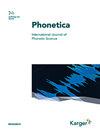图书说明:普通话声调的第二语言习得-超越第一语言迁移
IF 1.1
3区 文学
Q3 ACOUSTICS
引用次数: 2
摘要
张恒的《普通话声调的第二语言习得——超越第一语言迁移》,顾名思义,研究了第二语言(L2)学习者,特别是说非声调语言的人,即说英语、日语和韩语的人,是如何学习普通话声调的。这本书为第二语言习得的研究提供了新的贡献,旨在找出学习者错误的因素,超出了学习者的第一语言(L1)。本书共分七章,可进一步分为四个主要部分如下:第一部分(第一章和第二章)介绍了普通话声调的语音和音系,本书研究的三种语言(英语,日语和韩语)的母语的韵律结构,并全面概述了以前专门研究汉语声调的L1和L2习得的研究。第一章还强调了学习汉语声调的重要性和难度。第二章特别关注了以往研究在解释L1迁移时未能解决的三个难题,即“(1)轮廓音的位置效应(T2和T4如何受到预期协同发音的约束),(2)普通话声调习得的顺序(同声调对习得的难度与非同声调对的难度),(3)T3的悖论(恶名昭著的T3的习得)”(第26页)。第二部分(第3章)介绍了用于解决前一章中讨论的三个难题的方法。这一部分提供了测试材料、参与者、记录程序、评估第二语言语调的指导方针以及下一部分使用的数据的统计分析的简要总结。本章强调了一个详细的和逻辑的描述,以汉语为母语的人如何判断参与者产生的代币的正确性。除了正确判断外,还测量和评价了音高值作为评估标准之一。第三部分由本书的核心章节4-6组成,描述了第一部分提出的三个谜题对应的研究问题、假设、研究结果和实验讨论。三章各侧重于一个方面,所以这三章基本上是相互独立的,但又因为有同一组数据作为支撑而紧密联系在一起。第四章首先介绍了预期音协同发音的性质,然后计算了三组学习者产生的预期音的正确率、最大F0和错误类型,探讨了预期音协同发音在双音节汉语词汇产生T2和T4中的作用。结果表明,除了母语迁移外,预期异化还会导致二语成人学习者产生特定的错误模式。第五章的组织方式与第四章相同。通过对两个独立音系进行基于约束的分析,研究了不同声调对习得的困难。收稿日期:2019年3月15日。接受日期:2019年6月29日。发布时间:2019年8月8日本文章由计算机程序翻译,如有差异,请以英文原文为准。
Book notice: Second Language Acquisition of Mandarin Chinese Tones — Beyond First-Language Transfer
Second Language Acquisition of Mandarin Chinese Tones – Beyond First-Language Transfer by Hang Zhang, as the title suggests, looks at how second-language (L2) learners, specifically non-tonal language speakers, i.e. English, Japanese and Korean speakers, learn Mandarin Chinese tones. This book offers novel contributions to the research of the L2 acquisition with the aim to figure out the factors of learners’ errors that are beyond learners’ first language (L1). The book is structured in seven chapters, which can be further divided into four main parts as follows: The first part (chapters 1 and 2) offers an introduction to the phonetics and phonology of Mandarin Chinese tones, prosodic structures of the three languages that are the native languages of L2 groups (English, Japanese and Korean) researched in this book, and a comprehensive overview of the previous research devoted to the L1 and L2 acquisition of Chinese tones. Chapter 1 also highlights the importance and difficulty of learning Chinese tones. Chapter 2 particularly focuses on three puzzles that previous research has not resolved with the explanation of L1 transfer, i.e. “(1) positional effects of contour tones (how T2 and T4 are constrained by anticipatory coarticulation), (2) the order of the acquisition of Mandarin tones (the difficulty of the acquisition of identical tone pairs compared to nonidentical tone pairs), and (3) the paradox of T3 (the acquisition of the notorious T3)” (p. 26). The second part (chapter 3) presents the methodology that was used to address the three puzzles discussed in the previous chapter. This part provides the information on test materials, participants, recording procedure, guidelines on assessing L2 tones and a very brief summary of the statistical analyses of the data used in the next part. The chapter emphasizes a detailed and logical description of how native Chinese speakers judge the correctness of a token produced by participants. In addition to correctness judgements, pitch values were also measured and evaluated as one of the assessment criteria. The third part, which is constituted by the book’s three core chapters 4–6, describes the research questions, hypotheses, research findings and discussions of the experiments corresponding to the three puzzles raised in the first part. Each of the three chapters focuses on one aspect, so the three chapters are basically independent of each other, but they are also closely linked to each other as they are supported by the same set of data. Chapter 4 investigates the role of anticipatory coarticulation in the production of T2 and T4 in disyllabic Chinese words by first introducing the nature of anticipatory tone coarticulation and then calculating the accuracy rates, maximum F0 and error types of these tones as produced by the three groups of learners. The results show that beyond L1 transfer, anticipatory dissimilation results in particular error patterns by L2 adult learners. Chapter 5 is organized in the same way as chapter 4. It concerns the difficulty of the acquisition of different tone pairs by conducting a constraint-based analysis using two independent phonological Received: March 15, 2019 Accepted: June 29, 2019 Published online: August 8, 2019
求助全文
通过发布文献求助,成功后即可免费获取论文全文。
去求助
来源期刊

Phonetica
物理-声学
CiteScore
1.90
自引率
0.00%
发文量
15
审稿时长
>12 weeks
期刊介绍:
Contemporary research into spoken language employs a wide range of approaches, from instrumental measures to perceptual and neurocognitive measures, to computational models, for investigating the properties and principles of speech in communicative settings across the world’s languages. ''Phonetica'' is an international interdisciplinary forum for phonetic science that covers all aspects of the subject matter, from phonetic and phonological descriptions of segments and prosodies to speech physiology, articulation, acoustics, perception, acquisition, and phonetic variation and change. ''Phonetica'' thus provides a platform for a comprehensive understanding of speaker-hearer interaction across languages and dialects, and of learning contexts throughout the lifespan. Papers published in this journal report expert original work that deals both with theoretical issues and with new empirical data, as well as with innovative methods and applications that will help to advance the field.
 求助内容:
求助内容: 应助结果提醒方式:
应助结果提醒方式:


